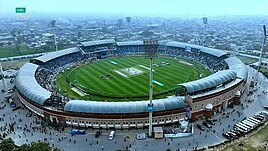
Back Multan Afrikaans ملتان Arabic ملتان ARZ मुल्तान AWA Multan Azerbaijani مولتان AZB Мултан Byelorussian Мултан Bulgarian মুলতান Bengali/Bangla Multan Catalan
Multan
ملتان | |
|---|---|
Clockwise from top: Tomb of Shah Rukn-e-Alam, Ghanta Ghar, Chenab river, Multan Cricket Stadium, Shahi Eid Gah Mosque, Blue-tiled tomb of Shah Gardez | |
| Coordinates: 30°11′52″N 71°28′11″E / 30.19778°N 71.46972°E | |
| Country | |
| Province | |
| Division | Multan |
| Autonomous towns | 6 |
| Union council | 4 |
| Government | |
| • Type | Metropolitan Corporation[1] |
| • Mayor | None (Vacant)[2] |
| • Deputy Mayor | None (Vacant)[2] |
| Area | |
| • City | 3,721 km2 (1,437 sq mi) |
| • Metro | 560 km2 (220 sq mi) |
| Population (2017)[6] | |
| • City | 1,827,001 |
| • Rank | 7th, Pakistan |
| • Density | 490/km2 (1,300/sq mi) |
| • Demonym | Multani |
| Time zone | UTC+05:00 (PKT) |
| Area code | 061 |
| Website | |
Multan (مُلتان; [mʊltaːn] ) is a city in Punjab, Pakistan, located on the bank of river Chenab. It is one of the five largest urban centres of Pakistan in 2024 and serves as the administrative centre of Multan Division.[7] A major cultural, religious and economic centre of Punjab region, Multan is one of the oldest inhabited cities of Asia, with a history stretching deep into antiquity.
Multan became part of the Achaemenid Empire in the early 6th century BC. The city was besieged by Alexander the Great during his campaign against the Mallian people. Later it was conquered by the Umayyad military commander Muhammad bin Qasim in 712 CE after the conquest of Sindh.[8] In 9th century it became capital of the Emirate of Multan.[9] The region came under the rule of the Ghaznavids and the Delhi Sultanate in the medieval period. In 1445, it became capital of the Langah Sultanate. After administrative reforms of Mughal emperor Akbar, it became one of the provinces of the Mughal Empire. In 1848, it was conquered by the British from Sikh Empire and became part of British Punjab.
The city was among most important trading centres and a great centre of knowledge and learning in the medieval Islamic Indian subcontinent,[10] and attracted a multitude of Sufi mystics in the 11th and 12th centuries, becoming a great centre of spirituality in entire South Asia and earning the city the sobriquet "City of Saints." The city, along with the nearby city of Uch, is renowned for its large number of Sufi shrines dating from that era.[11]
- ^ "Every fourth district in Punjab to have a metropolitan corporation". 27 December 2019.
- ^ a b "Administrators' appointments planned as Punjab LG system dissolves today". The Nation (newspaper). 31 December 2021. Retrieved 5 January 2022.
- ^ "Punjab Portal". Archived from the original on 14 April 2006. Retrieved 17 September 2009.
- ^ Area reference Archived 14 April 2006 at the Wayback Machine, Density reference Archived 26 September 2009 at the Wayback Machine statpak.gov.pk
- ^ "Pakistan: Tehsils and Talukas (Districts and Subdistricts) – Population Statistics, Charts and Map".
- ^ Cite error: The named reference
2017censusurbanwas invoked but never defined (see the help page). - ^ https://www.pbs.gov.pk/content/announcement-results-7th-population-and-housing-census-2023-digital-census
- ^ Firishtah, Muḥammad Qāsim Hindū Shāh Astarābādī (1770). The History of Hindostan. T. Becket and P.A. De Hondt.
- ^ "Tareekh-e-Pakistan (Wasti Ahad)". Yahya Amjad. Retrieved 14 February 2024.
- ^ Cite error: The named reference
Leviwas invoked but never defined (see the help page). - ^ Khan, Ahmad Fraz (18 January 2021). "Multan's mangoes and multinationals". DAWN.COM. Retrieved 20 January 2021.
© MMXXIII Rich X Search. We shall prevail. All rights reserved. Rich X Search






